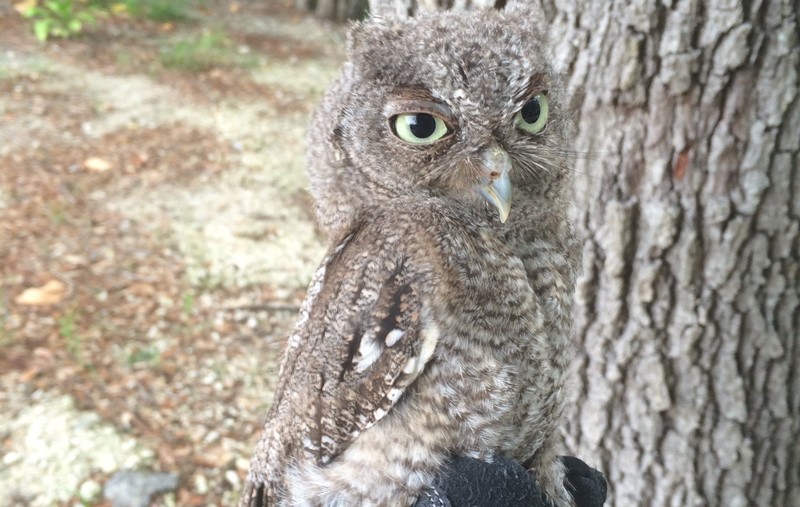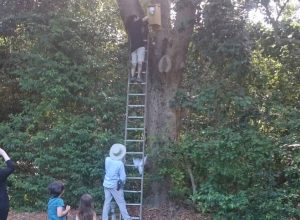
About a month ago our Falcon Batchelor Bird of Prey Center, which performs raptor rehabilitation, received two down-covered baby Eastern screech owls, one from a good Samaritan who found an owlet lost and wandering on a sidewalk near their home, the other from an FWC officer who had rescued a baby owl in the course of his duty. Luckily for the owlets, the facility has a highly trained staff, advanced medical equipment, and enough space to allow physical therapy and rehabilitation for the birds. Below, our Bird of Prey Center team explains how they raised the owlets from nestling to young adults, trained them to survive on their own, and reintroduced them to the wild with a method called “soft release.”
What condition were the chicks in when you received them?
They both came in with downy feathers, meaning they were about two to three weeks old. One was younger than the other and still had its eyes closed. The older of the two had eye infection that we treated with special avian antibiotics.
What’s the process when you receive wild birds?
First we conduct an initial examination and treat any medical issues. Treatment can range from something as simple as antibiotics to something as complex as surgery. We then create a species-specific diet for the birds and hand-feed or assist-feed them if necessary. Since both of the owlets were nestlings, they needed a little extra help. Luckily, we have Lucille, a resident Eastern screech owl who does a fantastic job as a foster mom! When owlets arrive in the nestling stage we place them with her as soon as we can. This allows them to imprint onto her instead of becoming comfortable with us. She teaches them necessary skills like how to feed themselves, defend themselves, recognize other owls, and become independent. Throughout these foster weeks, we monitor and weigh the owlets regularly to ensure they gain weight and develop properly. Once their flight feathers grow out, we place them in an enclosure outside where they start to reach a more wild and independent state.
How do you know the owls are ready for release?
The owls tell us when they are ready! In the flight cage, they go through the process of flight conditioning and live prey testing. Flight conditioning consists of staff members encouraging owls to fly for 5 to 10 minutes twice a day so as to build up their flight muscles and increase their endurance, all of which leads to a more successful release. Live prey testing is the last part of the process. We install night vision cameras and provide the owls with live prey. When we confirm a successful hunt, we know they’re ready to go.
You performed a soft release for these owls. Why, and what’s the difference between a hard and soft release?
The soft release option was the best choice for the owls because they came into our facility as owlets with no real understanding of the outside world beyond what we provided them.
A soft release involves placing the release-ready owls in a man-made nest box in an ideal habitat. We hang these nest boxes 10 to 30 feet high in a woodland area, and space them at least 100 feet apart, so the owls to have their own territories. After placing the owls in their boxes with appropriate food, we check the boxes daily. If the food is gone, the owl isn’t hunting successfully yet, so we keep providing meals. When they leave the food alone, we know they’re catching prey on their own.
A hard release is ideal for raptors we received as adults—they’ve already survived in the wild on their own. Once they go through rehabilitation we simply release them in an appropriate area, often in their old home territory.
How did you choose the nest sites for these owls?
We looked for an open woodland area that had no immediate threats present. These threats may be neighborhood cats, dogs, or raccoons. Ideally, we find a strong tree in which we can place the nest high up, so as to avoid any possible danger.
Why did you choose Vizcaya Museum & Gardens, and not Frost Science grounds?
While we generally aim to release birds in the area in which they were found, these Eastern screech owls came in as nestlings so they didn’t have their own territory established yet. While we have done releases on our own grounds in the past, we are striving to use different locations in order to establish populations elsewhere. Vizcaya Museum & Gardens is a great location due to the abundance of trees and open space. We can also walk there to monitor the birds and provide the nests with food.

Frost Science Aviculturist, Larissa Perez, placing one of the two rehabilitated Eastern screech owls in the nest box at Vizcaya Gardens
What should people do if they find an injured or orphaned Eastern screech owl or other bird of prey?
We encourage anyone who finds a baby or adult bird to contact the Falcon Batchelor Bird of Prey Center at 305-434-9575. The summer months are considered baby season, so many people are finding young birds on the ground. If the bird is obviously injured, you can bring them to us and we’ll assess the situation. If you find a baby bird that is featherless or slightly feathered, you can place them back to their nest. If the parents are hanging around but no nest is present, you can hang a makeshift nest like a basket or container lined with natural debris with the baby inside. The parents will continue to care for the baby. A lot of people find baby birds with feathers hopping around on the ground. This is a normal stage in their growing process called fledging in which they are too big for the nest but are still unable to fly. Think of it as the awkward teenager days! The parents stay close by and continue to feed the baby outside of the nest. If people find a bird in this life stage, we encourage them not to interfere and just keep a close eye out for any possible threats until the fledgling can fly away